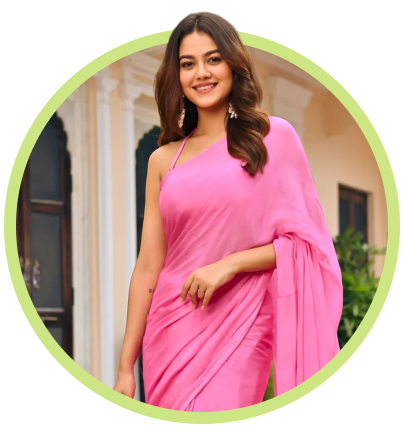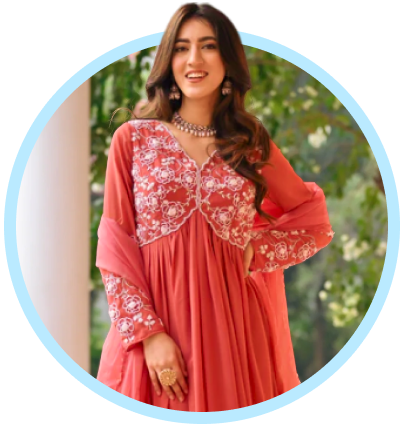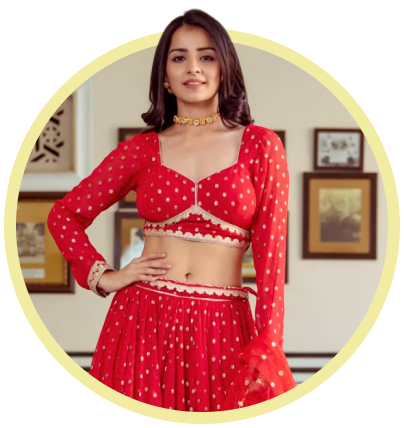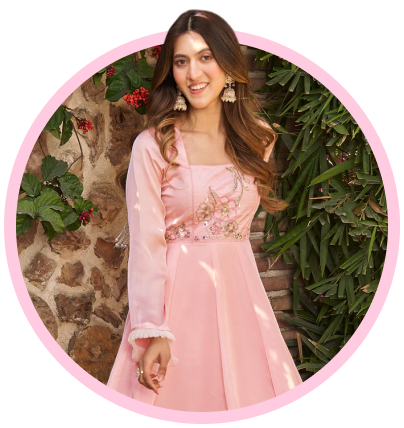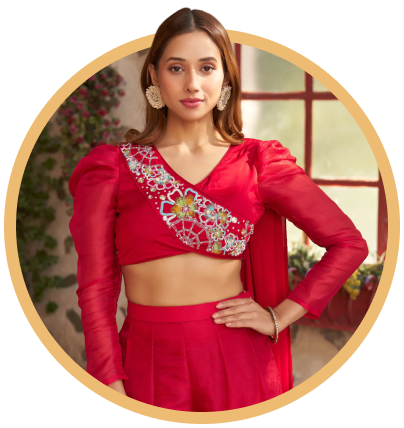As their name suggests, Pakistani suits were created there and are still worn by local ladies. Pakistani clothing is created to reflect the nation's unique culture and regional identity. Pakistan's ethnic attire is like several Central Asian countries and India.
History of Pakistani Suits:
People with Pakistani ancestry and those who reside there dress ethnically to express their national identity. It is a synthesis of various national ideas. The outfit is also made with consideration for the regional climate. Because of the two countries' extensive shared history, several regions' clothing patterns are similar.
Pakistani suits also remarkably resemble that of Central Asian ethnic groups. Undoubtedly, many young Pakistanis today dress in Western style. Nevertheless, Pakistan's traditional attire, the salwar kameez, is acknowledged as the nation's official attire worldwide.
Why are Embroidered Pakistani suits gaining popularity?
1. They are versatile:
Because of their distinctive design components and the variety of fabrics, prints, and embellishments that go into making them, Pakistani suits are adaptable. You can wear it to work and more laid-back events and festivities because it is renowned for being both comfy and elegant. For ladies of all ages, traditional Pakistani outfits have evolved. Instead of the traditional shawl worn with the dupatta, more and more women pair a lavishly embroidered
Zari-work dupatta with a monochromatic salwar kameez.
2. They have a great cultural significance:
Salwar suits come in various styles, from the high neck to the floor length. The Patiala-style trouser on a short kurta, which later transformed into the dhoti-style kameez, is one of the traditional salwar kameez fashions. Women now wear salwar kameez in the dhoti style throughout Pakistan and India, thanks to the popularity of television soap operas in those countries. Another well-liked outfit in the area is the Afghani salwar kameez, which consists of a
kaftan and trousers. A light, comfortable kurta, the kaftan is perfect for lounging about in.
3. Comes in a variety of fabrics:
A Pakistani suit can be made from silk, cotton, georgette, chiffon, and any of these fabrics. Furthermore, depending on the material, it can be worn on any occasion. For example, the cotton salwar kameez is the best choice for work and play in the summer due to its breathability and comfort for the wearer's skin. On the other hand, a silk or georgette salwar kameez with Zari embroidery suits formal occasions. A well-embroidered designer Pakistani suit creates an elegant appearance that is both straightforward and powerful.
4. Reasonable pricing:
You may choose from a wide range of price points with Pakistani suits, another benefit. Any budget can be met by the price range, which is large enough to include both designer and more affordable Pakistani suits. Pakistani partywear outfits are widely available online, and if you'd like, you may even have your suit custom-made. Designer Pakistani suits are offered in distinct categories on numerous e-commerce sites of manufacturers and distributors.
Bestsellers of Embroidered Pakistani suits in Kreeva:
1. Dashing Black Zari Georgette Pakistani Palazzo Salwar Suit:
Nothing can beat the elegance of black. Georgette fabric, a lightweight, sheer fabric with good drape and a little gritty texture, was used to make this salwar suit. The attire is black, a traditional and adaptable colour for formal settings. Zari embroidery, a form of metallic thread embroidery that gives the kameez an opulent and ornate touch, is a decoration. The loose-fitting, comfy palazzo pants are perfect for formal occasions wherever you need to be able to move around without restriction.
2. Adorable peach pink colour georgette base heavy work palazzo suit:
This is a kind of traditional Indian clothing that consists of three parts: palazzo trousers that are loose-fitting, a dupatta, and a long tunic-like top known as a kameez. Georgette fabric, a lightweight, sheer fabric with good flow and a little gritty texture is used to make this
palazzo suit. The attire is a delicate, feminine peach pink ideal for a spring or summer event. Heavy work craft is used to decorate the kameez, and this work may include embroidery, sequins, beads, or other ornaments. The backbreaking work gives the ensemble a rich, sumptuous appearance, perfect for formal occasions like weddings or celebrations. On the other hand, the loose-fitting, comfy palazzo pants offer the conventional suit a contemporary spin while facilitating easy movement.
3. White heavy embroidered Pant style suit:
White, a timeless and adaptable colour appropriate for various events, serves as the base colour of this pant-type suit. The elaborate motifs, which may include flower patterns, geometric shapes, or different decorative features, are heavily embroidered on the tunic-style top. The embroidery gives the ensemble a rich, sumptuous appearance, making it perfect for formal occasions like weddings or celebrations. The trousers are made in a contemporary and fashionable pant style, which means they are tailored and fitted to the legs to provide a chic and elegant appearance. The trousers are easy to wear and ideal for any occasion because they are created from a lovely and breathable fabric.
How to style Pakistani suits?
1. Everything-compatible cotton suits:
For any situation, cotton suits are a flexible and cosy choice. They are appropriate for wearing to work, a casual lunch, and even weddings. Choosing the right accessories is the secret to dressing them. You can wear them with simple jewellery and flat sandals for a more laid-back appearance. Add some statement earrings, a handbag, and heels for a dressier appearance.
2. Ethnic party attire:
The main features of Pakistani party clothing are embellishments, vivid colours, and sumptuous fabrics. You can choose an outfit with a long flowy silhouette that is richly adorned for weddings or other formal occasions. Pair it with some statement jewellery and high heels for a dazzling look. To let the clothing shine, keep the makeup and hair essential.
3. Make formal attire cosy:
Pakistani formal attire can be bulky and unpleasant, particularly in the heat. So, you might choose softer materials like chiffon or silk to make it more comfortable. You might also wear clothing with shorter sleeves or hemlines to stay calm.
4. Extra-Large Clothing:
There are many possibilities for people with less slender bodies in Pakistani attire; therefore, it is not exclusively for those with slim forms. Choose a fabric that drapes well and doesn't cling to your body when styling a plus-size outfit.
5. Indo-Western Fashion:
Wear a classic Pakistani kurta with jeans or leggings for a more relaxed appearance. You can also combine and contrast various designs and materials to create a distinctive costume. To prevent appearing too flashy, balance the old and modern components.
Final Words:
These suits are a traditional Pakistani attire comprising three pieces: a loose-fitting pair of trousers called palazzo, a scarf called a dupatta, and a tunic-style top called a kameez. The outfits are decorated with complex embroidered patterns, which give the attire an opulent and elaborate feel. They are fashioned from delicate fabrics that are light, breathable, and comfortable fabrics, like georgette, silk, or chiffon. As a result, customers can enjoy the convenience of obtaining traditional Pakistani suits without flying anywhere. This can help customers save time and money and provide them access to the newest styles in Pakistani clothing.
Frequently asked questions:
1. What is a Pakistani suit?
Women in Pakistan and other South Asian nations typically dress in Pakistani suits, traditional apparel. They usually come in three pieces:
- A scarf called a dupatta.
- Loose-fitting trousers called salwar or palazzo.
- A long tunic-style top called a kameez.
2. Why are Pakistani suits loose?
For several reasons, Pakistani suits are made to be loose-fitting. First, the loose fit promotes increased comfort and mobility, crucial in South Asia's hot and muggy climate. This fit also promotes excellent airflow, which can keep the wearer more relaxed and comfortable.


